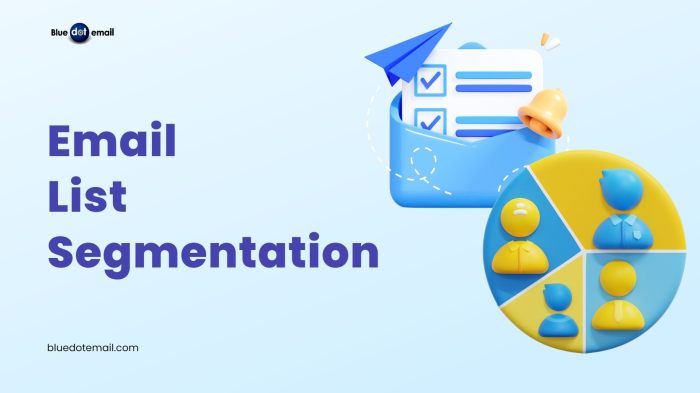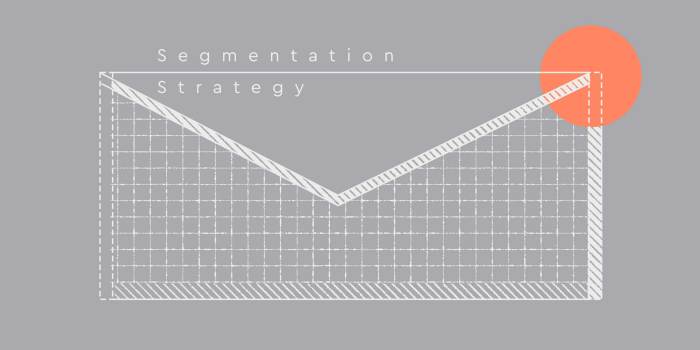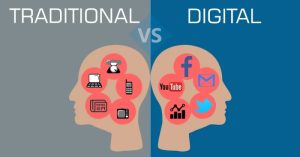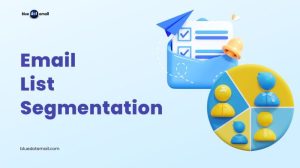
Step right up to the world of Email list segmentation strategies! Get ready for a rollercoaster ride filled with tips and tricks to level up your email marketing game.
From demographics to engagement, we’ve got all the insider info to help you segment like a pro and see those open rates soar!
Introduction to Email List Segmentation Strategies
Email list segmentation is the process of dividing your email subscribers into smaller groups based on specific criteria such as demographics, behavior, or interests. This allows you to send targeted and personalized content to different segments of your audience.Segmenting your email list is crucial for marketing purposes as it helps increase engagement, improve open and click-through rates, and ultimately drive conversions.
By sending relevant content to the right people at the right time, you can build stronger relationships with your subscribers and improve the overall effectiveness of your email marketing campaigns.
Importance of Email List Segmentation
- Increases engagement: Segmented emails are more likely to be opened and clicked on by subscribers who find the content relevant to their needs and interests.
- Improves personalization: By tailoring your messages to specific segments of your audience, you can deliver more personalized and targeted content that resonates with each individual.
- Boosts conversion rates: When you send relevant offers or information to the right segment of your audience, you increase the chances of converting them into customers or taking the desired action.
Examples of Segmentation in Email Marketing
For example, an e-commerce store can segment their email list based on past purchase behavior to send targeted product recommendations to customers who have previously bought similar items. A software company can segment their list by industry to deliver industry-specific content and solutions to their subscribers.
Types of Email List Segmentation
Email list segmentation is a crucial part of email marketing strategy that involves dividing your email subscribers into smaller groups based on specific criteria. This allows you to send targeted and personalized emails to different segments, increasing engagement and conversion rates. There are various types of email list segmentation, including demographics-based, behavior-based, and engagement-based segmentation.
Demographics-based Segmentation
Demographics-based segmentation involves dividing your email list based on characteristics such as age, gender, location, income, education level, and more. By segmenting your list by demographics, you can send content that is relevant to the specific needs and interests of each group. For example, you can send different promotions to male and female subscribers or tailor your messaging based on the age group of your audience.
- Age: Sending age-appropriate content or promotions.
- Location: Targeting subscribers based on their geographical location.
- Income: Offering products or services that match their income level.
Behavior-based Segmentation
Behavior-based segmentation involves dividing your email list based on how subscribers interact with your emails or website. This can include factors such as past purchases, website visits, email opens, clicks, and more. By segmenting your list based on behavior, you can send relevant content to subscribers based on their actions and interests.
- Past Purchases: Recommending similar products or related items.
- Email Opens: Sending follow-up emails to engage with active subscribers.
- Website Visits: Sending targeted promotions based on products viewed on the website.
Engagement-based Segmentation
Engagement-based segmentation involves dividing your email list based on how engaged subscribers are with your emails. This can include factors such as open rates, click-through rates, inactive subscribers, and more. By segmenting your list based on engagement, you can re-engage inactive subscribers or reward highly engaged subscribers with exclusive content or offers.
- Open Rates: Sending re-engagement campaigns to subscribers with low open rates.
- Click-Through Rates: Sending targeted content to subscribers who frequently click on links.
- Inactive Subscribers: Offering special promotions to re-engage inactive subscribers.
Benefits of Email List Segmentation

Segmenting your email list can have a significant impact on the success of your email marketing campaigns. By tailoring your messages to specific groups of subscribers, you can increase open and click-through rates, improve customer engagement, and effectively target different customer segments.
Higher Open and Click-Through Rates
Segmenting your email list allows you to send more targeted and relevant content to your subscribers. By sending emails that cater to the specific interests and preferences of different segments of your audience, you are more likely to capture their attention and encourage them to engage with your emails. This personalized approach can lead to higher open rates and increased click-through rates, ultimately driving more traffic to your website and increasing conversions.
Increased Customer Engagement
Personalized content resonates with subscribers on a deeper level, making them more likely to interact with your emails. When subscribers feel like the content is tailored specifically to them, they are more inclined to open, read, and act on your emails. By segmenting your email list and creating personalized messages, you can build stronger relationships with your subscribers and boost customer engagement, leading to higher retention rates and increased loyalty.
Effective Targeting of Specific Customer Groups
Segmenting your email list based on demographics, behavior, or preferences allows you to target specific customer groups with relevant and timely content. By understanding the unique needs and interests of different segments of your audience, you can tailor your messaging to address their pain points, offer relevant solutions, and drive conversions. This targeted approach enables you to deliver the right message to the right people at the right time, maximizing the effectiveness of your email marketing efforts.
Strategies for Effective Email List Segmentation
When it comes to effective email list segmentation, there are several key strategies that can help you maximize the impact of your email marketing campaigns. From collecting relevant data to creating buyer personas and utilizing automation tools, here are some best practices to consider:
Collecting Relevant Data for Segmentation
- Implement progressive profiling on your sign-up forms to gradually gather more information about your subscribers.
- Track user behavior on your website to understand their preferences and interests.
- Utilize surveys and feedback forms to gather insights directly from your subscribers.
Creating Buyer Personas for Targeted Segmentation
- Segment your audience based on demographics, behavior, and preferences to create detailed buyer personas.
- Use data analytics tools to analyze customer data and identify patterns that can help you create accurate personas.
- Regularly update your buyer personas to ensure they reflect the evolving needs and preferences of your audience.
Using Automation Tools for Segmentation
- Utilize email marketing platforms that offer automation features to easily segment your email list based on predefined criteria.
- Set up triggered emails based on user actions to deliver personalized content to each segment of your audience.
- Use dynamic content blocks in your emails to tailor the message to the specific interests of each segmented group.
Marketing E-Commerce
Email list segmentation plays a crucial role in enhancing e-commerce marketing efforts. By dividing your email list into targeted segments based on specific criteria, you can personalize your email content and promotions to better meet the needs and interests of your customers.
Personalized Email Content for Driving Sales
Personalization is key in e-commerce email marketing. Tailoring your email content to the preferences and behaviors of each segment of your email list can significantly increase engagement and drive sales. By sending relevant product recommendations, personalized offers, and targeted content, you can create a more personalized shopping experience for your customers, leading to higher conversion rates and increased customer loyalty.
- Utilize customer purchase history and browsing behavior to recommend products that are likely to interest each segment.
- Include personalized product recommendations based on previous purchases or items left in the shopping cart to encourage repeat purchases.
- Create targeted email campaigns for specific segments, such as loyal customers, new subscribers, or inactive users, to re-engage and drive sales.
Personalized emails have been shown to generate 6x higher transaction rates than non-personalized emails (Experian).
Role of Targeted Promotions
Targeted promotions play a vital role in e-commerce email marketing by incentivizing customers to make a purchase. By offering exclusive discounts, limited-time offers, and personalized promotions to specific segments of your email list, you can create a sense of urgency and drive immediate action from your customers.
- Segment your email list based on customer preferences, purchase history, or engagement levels to deliver targeted promotions that resonate with each segment.
- Create personalized discount codes or offers for different segments to encourage repeat purchases and increase customer lifetime value.
- Use targeted promotions to promote new product launches, seasonal sales, or clearance events to drive traffic and boost sales.
Research shows that personalized promotional emails have a 29% higher unique open rate and 41% higher unique click rate than non-personalized emails (Experian).
Advertising
In the world of digital marketing, advertising plays a crucial role in driving sales and increasing brand awareness. Email list segmentation can greatly enhance the effectiveness of advertising campaigns by allowing marketers to tailor their messages to specific audience segments, resulting in higher engagement and conversion rates.
Improved ROI through Segmentation
- Segmented email lists enable marketers to deliver targeted ads to specific customer groups, increasing the relevance of the message and improving click-through rates.
- By personalizing ad content based on customer preferences and behaviors, advertisers can achieve higher ROI as the likelihood of conversion is higher when the message resonates with the recipient.
- Tracking the performance of segmented campaigns allows marketers to optimize their ad spend by focusing on the segments that yield the best results, thus maximizing ROI.
Importance of Targeted Messaging
- Targeted messaging in advertising through email ensures that the right message reaches the right audience, leading to a more personalized and engaging user experience.
- Segmented email lists help in delivering relevant content to customers, increasing the likelihood of conversion and building stronger brand loyalty.
- By understanding the unique needs and preferences of different customer segments, advertisers can create compelling ad campaigns that drive action and boost sales.
Examples of Successful Campaigns
- A clothing retailer segmented their email list based on past purchase behavior and sent targeted ads showcasing products similar to what each customer had previously bought. This resulted in a 20% increase in conversion rates.
- An online travel agency segmented their list by travel preferences and destinations of interest. By sending customized ads promoting exclusive travel deals to each segment, they saw a 15% increase in bookings.
- A software company divided their email list into free trial users and paying customers. They sent targeted ads offering upgrade discounts to free trial users, leading to a 25% increase in conversions to paid subscriptions.
Affiliate Marketing
Email list segmentation can greatly benefit affiliate marketing strategies by allowing marketers to target specific segments of their audience with relevant affiliate products or services. This personalized approach increases the chances of conversion as it caters to the unique needs and interests of each segment.
Personalized Recommendations in Affiliate Marketing Emails
Using email list segmentation, marketers can send personalized recommendations to different segments based on their past interactions, purchase history, and preferences. By tailoring the affiliate product recommendations to each segment, marketers can increase engagement and drive more conversions.
- Segment your email list based on past purchases or browsing behavior to recommend related affiliate products that are likely to interest the recipients.
- Utilize dynamic content in emails to showcase different affiliate products to different segments, ensuring each recipient receives personalized recommendations.
- Include customer reviews or testimonials in affiliate marketing emails to build trust and credibility, increasing the likelihood of conversions.
Using Segmented Lists to Promote Affiliate Products Effectively
Segmented lists can be leveraged to promote affiliate products effectively by targeting specific segments with tailored messaging and offers. This approach ensures that the right products are promoted to the right audience, maximizing the chances of conversion.
- Create targeted email campaigns for each segment, highlighting affiliate products that align with their interests and preferences.
- A/B test different email variations to determine which messaging and offers resonate best with each segment, optimizing conversion rates.
- Monitor and analyze the performance of affiliate marketing campaigns targeted at different segments, adjusting strategies based on the results to improve overall effectiveness.
Branding
Email list segmentation plays a crucial role in strengthening brand messaging by allowing businesses to tailor their communication to specific audience segments. This personalized approach helps in creating a more impactful and relevant brand experience for customers, ultimately leading to increased brand loyalty and engagement.
Impact of Targeted Communication on Brand Perception
- By sending targeted messages to different segments of your email list, you can address the specific needs and interests of each group, showing that you understand and value them as individuals.
- This personalized communication helps in building a stronger connection with your audience, enhancing their perception of your brand as one that cares about their preferences and priorities.
- Consistent and relevant messaging through segmentation can also help in shaping a positive brand image in the minds of consumers, leading to increased trust and credibility.
Contribution of Segmentation to Brand Loyalty
- Segmentation allows you to send targeted offers, promotions, and content that resonate with each segment, increasing the likelihood of conversions and repeat purchases.
- By understanding the unique characteristics and behaviors of different segments, you can create loyalty programs and rewards that are tailored to their preferences, fostering a sense of exclusivity and appreciation.
- Effective segmentation can help in delivering a more personalized and relevant brand experience, leading to increased customer satisfaction and loyalty over time.
Direct Marketing
Email list segmentation plays a crucial role in enhancing direct marketing efforts by allowing businesses to tailor their messages to specific segments of their audience. This personalized approach can significantly increase engagement and conversion rates.
Personalized Offers in Direct Marketing Emails
- Personalized offers, such as discounts or promotions based on customer preferences and behavior, can grab the recipient’s attention and encourage them to take action.
- By segmenting your email list and sending targeted offers, you can create a sense of exclusivity and relevance for each recipient, increasing the likelihood of a positive response.
- Including the recipient’s name in the subject line or body of the email can also make the message feel more personal and engaging.
Best Practices for Using Segmented Lists in Direct Marketing Campaigns
- Segment your email list based on demographics, purchase history, engagement level, or any other relevant criteria to ensure that your messages are highly targeted.
- Regularly analyze the performance of your email campaigns to understand which segments are responding best to your messages and adjust your segmentation strategy accordingly.
- A/B testing different offers, subject lines, or content for each segment can help you identify the most effective strategies for each group of recipients.
Internet Marketing

In today’s digital age, internet marketing plays a crucial role in reaching and engaging with target audiences. Email list segmentation is a powerful strategy that can enhance the effectiveness of internet marketing campaigns by delivering personalized and relevant content to specific segments of your audience.
Relationship between Email List Segmentation and Internet Marketing
- Segmenting your email list allows you to tailor your internet marketing strategies based on the interests, behaviors, and preferences of different segments of your audience.
- By sending targeted messages to specific segments, you can increase engagement, conversion rates, and overall campaign performance.
- Internet marketing efforts, such as social media advertising, content marketing, and search engine optimization, can be more impactful when supported by segmented email lists.
Improving Effectiveness of Internet Marketing Campaigns
- Segmented email lists enable you to create personalized campaigns that resonate with each segment of your audience, leading to higher open rates and click-through rates.
- By analyzing the data from segmented email campaigns, you can gain valuable insights into the preferences and behaviors of different audience segments, allowing you to optimize your internet marketing strategies accordingly.
- Effective segmentation can lead to increased customer loyalty, brand awareness, and ultimately, higher ROI for your internet marketing efforts.
Examples of Successful Internet Marketing Tactics with Segmented Email Lists
- Personalized recommendations based on past purchases or browsing history can drive repeat purchases and increase customer lifetime value.
- Targeted promotional offers for specific segments, such as loyal customers or new subscribers, can boost conversion rates and drive sales.
- Drip campaigns tailored to different stages of the customer journey can nurture leads, build trust, and ultimately drive conversions.
Mailing Lists
Email list segmentation plays a crucial role in the management of mailing lists. By dividing your subscribers into different segments based on their preferences, behaviors, or demographics, you can tailor your email content to better resonate with each group. This targeted approach allows you to send more relevant and personalized messages, leading to higher engagement and conversion rates.
Impact on Mailing List Management
- Organizing Subscribers: Segmenting your mailing list helps you categorize subscribers into specific groups, making it easier to manage and target them effectively.
- Improved Deliverability: Sending relevant content to segmented lists can boost engagement, reduce spam complaints, and improve email deliverability.
- Enhanced Personalization: Tailoring your messages to different segments allows you to create more personalized and engaging content, leading to better relationships with your subscribers.
Role of Targeted Content
- Increased Engagement: Providing targeted content that aligns with the interests and preferences of each segment can significantly boost engagement rates and encourage subscribers to interact with your emails.
- Improved Conversion Rates: By delivering content that resonates with specific segments, you can drive more conversions and sales as subscribers are more likely to respond positively to relevant offers and information.
- Building Trust and Loyalty: Sending personalized content demonstrates that you understand your subscribers’ needs and preferences, helping to build trust and loyalty over time.
Tips for Optimizing Mailing Lists through Segmentation Strategies
- Collect Relevant Data: Gather information about your subscribers such as demographics, purchase history, and preferences to create meaningful segments.
- Use Automation: Utilize email marketing tools to automate the segmentation process based on subscriber behavior, interactions, or preferences.
- Test and Refine: Continuously test different segmentation strategies to see what works best for your audience and refine your approach based on the results.
- Monitor Performance: Keep track of key metrics such as open rates, click-through rates, and conversions to evaluate the effectiveness of your segmentation strategies and make necessary adjustments.
Final Thoughts
As we wrap up our journey through Email list segmentation strategies, remember: personalized content is key, automation is your friend, and targeted segmentation is the secret sauce to marketing success!
Questions Often Asked
Can segmentation really improve email marketing effectiveness?
Absolutely! By targeting specific customer groups effectively, segmentation can lead to higher open and click-through rates.
How can I collect relevant data for segmentation?
Start by analyzing your current customer database and interactions to gather valuable insights for effective segmentation.
Why is personalized content so crucial for customer engagement?
Personalized content shows your audience that you understand their needs and preferences, leading to increased engagement and loyalty.






